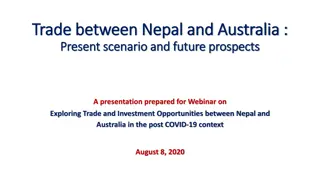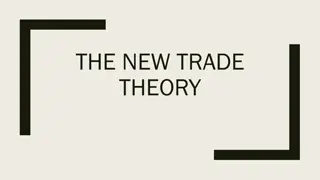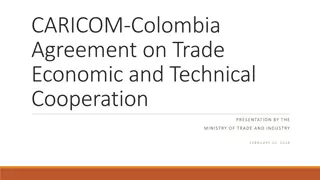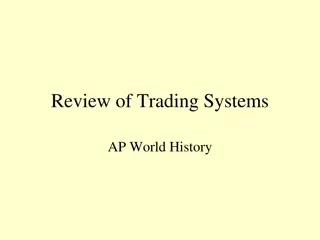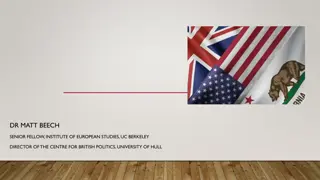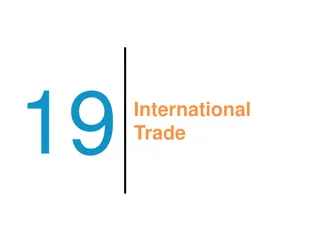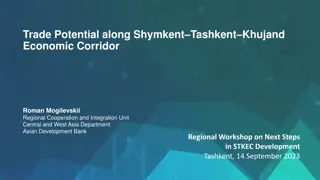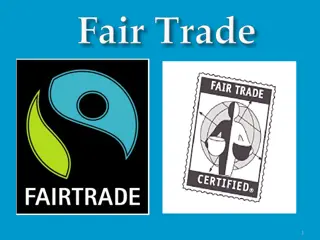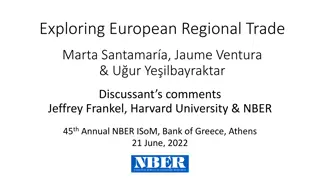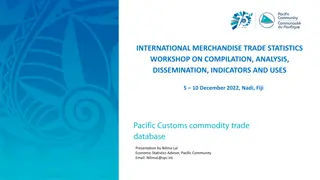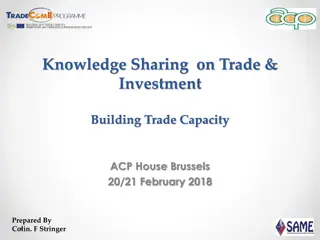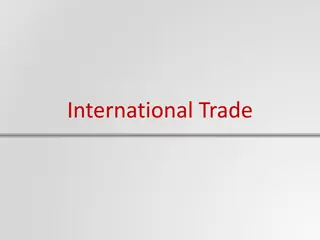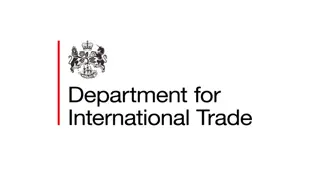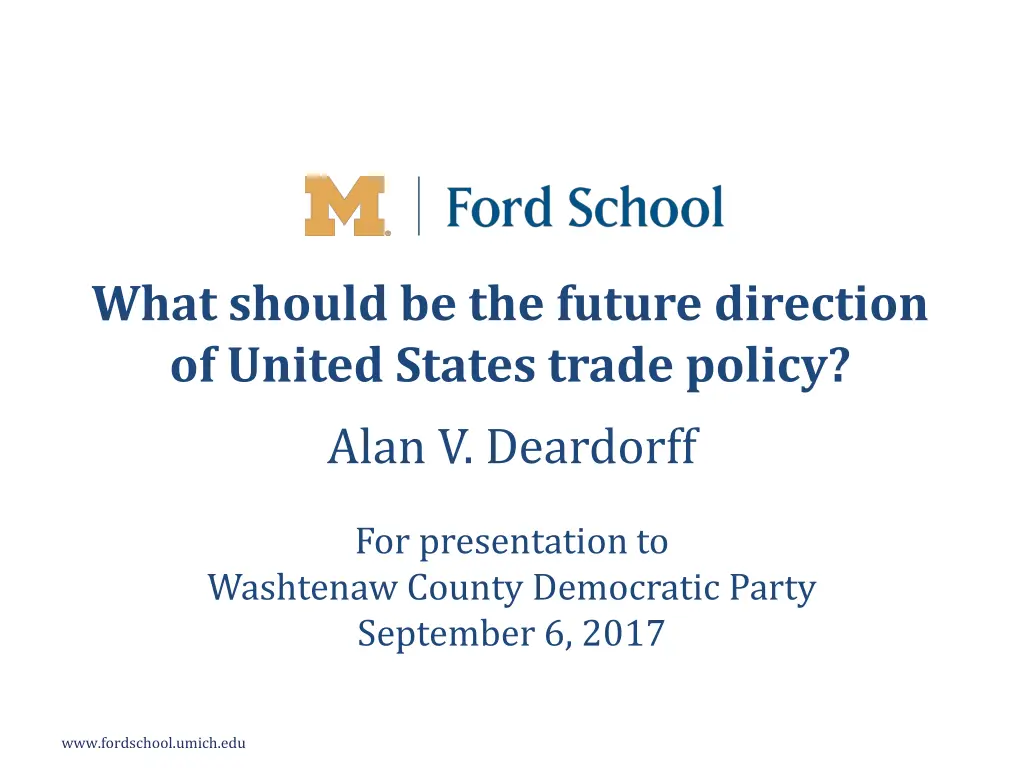
Future Direction of United States Trade Policy: Analysis and Recommendations
Explore the evolution of US trade policy, the impact of past decisions, and considerations for the future, including changes under the Trump administration and addressing trade deficits. Gain insights into international trade agreements, tariffs, GDP implications, manufacturing trends, and unemployment rates.
Download Presentation

Please find below an Image/Link to download the presentation.
The content on the website is provided AS IS for your information and personal use only. It may not be sold, licensed, or shared on other websites without obtaining consent from the author. If you encounter any issues during the download, it is possible that the publisher has removed the file from their server.
You are allowed to download the files provided on this website for personal or commercial use, subject to the condition that they are used lawfully. All files are the property of their respective owners.
The content on the website is provided AS IS for your information and personal use only. It may not be sold, licensed, or shared on other websites without obtaining consent from the author.
E N D
Presentation Transcript
What should be the future direction of United States trade policy? Alan V. Deardorff For presentation to Washtenaw County Democratic Party September 6, 2017 www.fordschool.umich.edu
Outline US Trade Policy Past Policy Performance US Trade Policy Future Without Trump With Trump Addressing the trade deficit Renegotiating NAFTA Other 2 www.fordschool.umich.edu
US Trade Policy Past US Leadership since World War II Rounds of multilateral tariff reductions Discipline on nontariff barriers Expanded coverage to Services Intellectual Property All done through GATT, then WTO 3 www.fordschool.umich.edu
US Trade Policy Past International Rule of Law GATT/WTO agreed rules for uses of trade policies Enforced through sanctioned retaliation Rules permitted trade remedies, but constrained their use Safeguards tariffs Anti-dumping duties Countervailing duties (against subsidies) 4 www.fordschool.umich.edu
US Trade Policy Past Regional trade agreements EU was pioneer with customs union 6-country EEC grew to 28-country EU (soon 27) US resisted, but then negotiated US-Canada FTA 1989 NAFTA 1994 Many others followed, mostly with FTAs 5 www.fordschool.umich.edu
FTAs 6 www.fordschool.umich.edu
US GDP & Trade 7 www.fordschool.umich.edu
US Tariffs 8 www.fordschool.umich.edu
US Manufacturing Employment 9 www.fordschool.umich.edu
US Manufacturing Output 10 www.fordschool.umich.edu
US Unemployment 11 www.fordschool.umich.edu
US Labor Force Participation 12 www.fordschool.umich.edu
13 www.fordschool.umich.edu
US Unions 14 www.fordschool.umich.edu
China manufacturing 15 www.fordschool.umich.edu
US and China Current Account Balances 16 www.fordschool.umich.edu
17 www.fordschool.umich.edu
US Trade Policy Future: Without Trump More multilateral liberalization? No. Attempt of Doha Round failed 18 www.fordschool.umich.edu
US Trade Policy Future: Without Trump More regional agreements? Yes Trans-Pacific Partnership (12 countries) Trans-Atlantic Trade and Investment Partnership (US and EU) 19 www.fordschool.umich.edu
US Trade Policy Future: Without Trump Continued support for World Trade Organization US would take its disputes to the WTO US would work with other WTO members to advance the cause of trade with smaller agreements 20 www.fordschool.umich.edu
US Trade Policy Future: Without Trump Continued use of WTO-permitted trade remedies ( trade law enforcement ) Safeguards tariffs Against imports causing injury Anti-dumping duties Against imports unfairly priced Countervailing duties Against subsidized imports 21 www.fordschool.umich.edu
Trump Trade Policy: Trade Deficits First priority: Reduce US trade deficits Overall trade deficit with the world Bilateral trade deficits with China, Mexico, Canada, etc. Trump blames trade agreements (NAFTA, WTO) for being unfair to US and causing these deficits Says that deficits, in turn, cost US jobs 22 www.fordschool.umich.edu
Trump Trade Policy: Trade Deficits Can he reduce US trade deficits? No! Not with tariffs or trade restrictions. Overall trade deficit equals Imports minus exports What we buy minus what we produce Spending minus income No trade agreement (or trade policy) will change the fact that the US spends more than its income 23 www.fordschool.umich.edu
Trump Trade Policy: Trade Deficits Bilateral trade deficits with individual countries? Yes, perhaps. The sum of all bilateral deficits must equal the total, and that won t change, unless it reduces US spending But policies can re-direct our imports from one country to another Example, if we cut our imports from Mexico, we ll buy that much more from someone else (China?) 24 www.fordschool.umich.edu
Trump Trade Policy: NAFTA Trump called NAFTA: The single worst trade deal ever approved in this country Was it? 25 www.fordschool.umich.edu
NAFTA What Happened Peso Dropped One Year After Mexico Exchange Rate Quarterly 1988-2004 NAFTA Peso Crisis 0.5 0.4 $/peso 0.3 0.2 0.1 0 Econ 340, Deardorff, Lecture 18: PTAs 26 www.fordschool.umich.edu
NAFTA: What Happened - Mexico Reserves Dropped at Once Mexico Reserves Quarterly 1988-2005 NAFTA Peso Crisis 70.0 60.0 50.0 $ billion 40.0 30.0 20.0 10.0 0.0 1988.1 1989.2 1990.3 1991.4 1993.1 1994.2 1995.3 1996.4 1998.1 1999.2 2000.3 2001.4 2003.1 2004.2 Econ 340, Deardorff, Lecture 18: PTAs 27 www.fordschool.umich.edu
NAFTA: What Happened - Mexico GDP Fell after Peso Crisis Mexico Real GDP 1993=100 NAFTA Peso Crisis 160 140 120 100 80 60 40 20 0 Econ 340, Deardorff, Lecture 18: PTAs 28 www.fordschool.umich.edu
NAFTA: What Happened - Mexico Imports Fell after Crisis NAFTA Peso Crisis Mexico Trade 1988-2004 60.0 50.0 40.0 $ billion 30.0 20.0 10.0 0.0 1988.1 1989.2 1990.3 1991.4 1993.1 1994.2 1995.3 1996.4 1998.1 1999.2 2000.3 2001.4 2003.1 2004.2 Exports Imports Econ 340, Deardorff, Lecture 18: PTAs 29 www.fordschool.umich.edu
NAFTA: What Happened - Mexico Wages Fell after Crisis Mexico Nominal Wages Quarterly 1990- 2005 NAFTA Peso Crisis Index 1993.4=100 120 100 80 60 40 20 0 1990.1 1991.2 1992.3 1993.4 1995.1 1996.2 1997.3 1998.4 2000.1 2001.2 2002.3 2003.4 2005.1 Econ 340, Deardorff, Lecture 18: PTAs 30 www.fordschool.umich.edu
NAFTA: What Happened - Mexico Real Wages Plummeted! Mexico Real Wages, Quarterly 1990-2005 NAFTA Peso Crisis 120 Index 1993.4=100 100 80 60 40 20 0 1990.1 1991.2 1992.3 1993.4 1995.1 1996.2 1997.3 1998.4 2000.1 2001.2 2002.3 2003.4 2005.1 Econ 340, Deardorff, Lecture 18: PTAs 31 www.fordschool.umich.edu
NAFTA: What Happened - US Unemployment: No effect (or fell) US Unemployment Rate Quarterly 1988-2005 NAFTA Peso Crisis 9.0 8.0 7.0 6.0 Percent 5.0 4.0 3.0 2.0 1.0 0.0 1988.1 1989.1 1990.1 1991.1 1992.1 1993.1 1994.1 1995.1 1996.1 1997.1 1998.1 1999.1 2000.1 2001.1 2002.1 2003.1 2004.1 2005.1 Econ 340, Deardorff, Lecture 18: PTAs 32 www.fordschool.umich.edu
NAFTA: What Happened - US Trade: Continued growth US Trade NAFTA Peso Crisis Quarterly 1988-2004 500 400 300 200 $ billion 100 0 1988.1 1989.1 1990.1 1991.1 1992.1 1993.1 1994.1 1995.1 1996.1 1997.1 1998.1 1999.1 2000.1 2001.1 2002.1 2003.1 2004.1 -100 -200 -300 Exports Imports Current Acct. Econ 340, Deardorff, Lecture 18: PTAs 33 www.fordschool.umich.edu
NAFTA: What Happened - US Real Wage: No Change US Real Wage Quarterly 1988-2005 NAFTA Peso Crisis 120 Index 1993.4=100 100 80 60 40 20 0 1988.1 1989.2 1990.3 1991.4 1993.1 1994.2 1995.3 1996.4 1998.1 1999.2 2000.3 2001.4 2003.1 2004.2 Econ 340, Deardorff, Lecture 18: PTAs 34 www.fordschool.umich.edu
NAFTA: What Happened Trade Grew, More To US than From NAFTA Peso Crisis US-Mexico Trade 150 100 $ billion 50 0 1991 1992 1993 1994 1995 1996 1997 1998 1999 2000 2001 2002 2003 Mexico to US US to Mexico Econ 340, Deardorff, Lecture 18: PTAs 35 www.fordschool.umich.edu
Trump Trade Policy: NAFTA Threatened first to pull out of NAFTA Was persuaded to renegotiate instead By leaders of Canada and Mexico By US business interests Why? Because NAFTA permitted supply chains to extend across borders. Trump seeks to use the threat to get a better deal 36 www.fordschool.umich.edu
Trump Trade Policy: NAFTA What will the better deal be? Tighter rules of origin Improved access to Canada for US dairy Revise Investor-State Dispute Settlement Drop Chapter 19, that arbitrates AD & CVD Include Buy American for governments Prevent currency manipulation 37 www.fordschool.umich.edu
Trump Trade Policy: Other Issues Several that have come and gone Huge tariff on China Mentioned during campaign, but not since Border adjustment tax Resisted by US retailers Tariffs on imports of steel and aluminum Resisted by manufacturers that need these inputs 38 www.fordschool.umich.edu
Trump Trade Policy: Other Issues Korea-US FTA: Pull out of that too, or renegotiate? (Said yes, Sep 2; said no Sep 5) Case against China for violating US intellectual property rights Filed under Section 301 of US trade law Hasn t been used for years, and likely illegal under WTO Actions on currency manipulation? 39 www.fordschool.umich.edu
Conclusions? It s very hard to know what US trade policy will be under Trump At his most extreme, he threatens Greatly increased protectionism Trade war Extreme economic harm to US His actions so far have mostly been far more mild and conventional 40 www.fordschool.umich.edu



